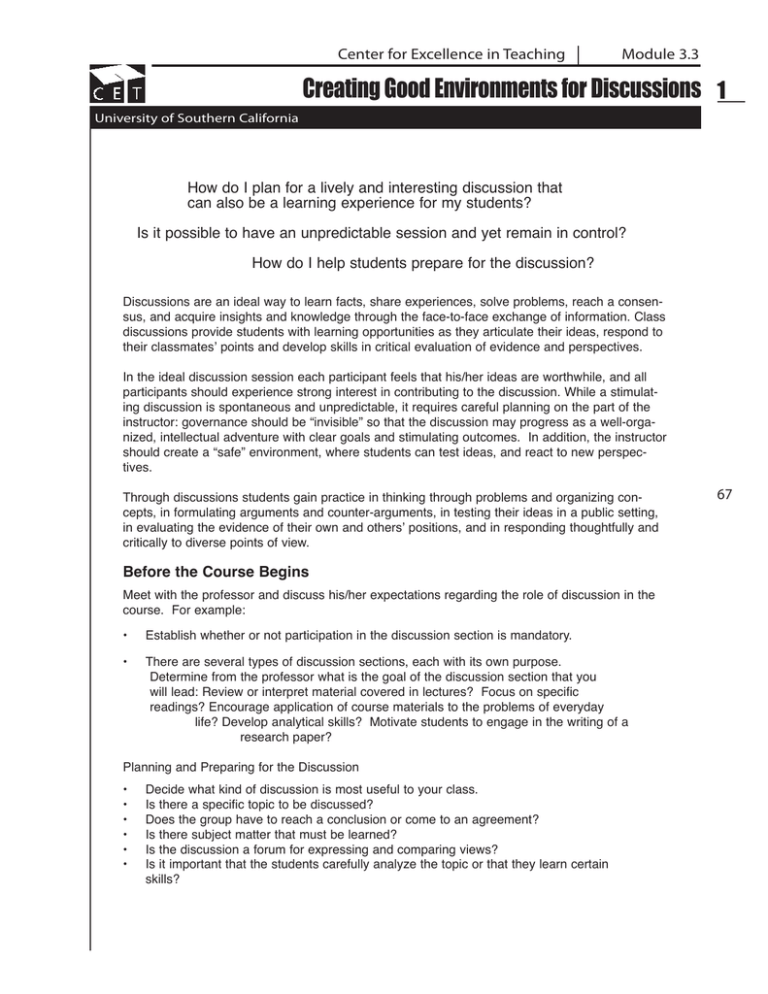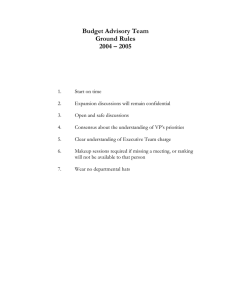3.3 Preparing and Creating Good Environments for Discussions
advertisement

Center for Excellence in Teaching Module 3.3 Creating Good Environments for Discussions 1 University of Southern California How do I plan for a lively and interesting discussion that can also be a learning experience for my students? Is it possible to have an unpredictable session and yet remain in control? How do I help students prepare for the discussion? Discussions are an ideal way to learn facts, share experiences, solve problems, reach a consensus, and acquire insights and knowledge through the face-to-face exchange of information. Class discussions provide students with learning opportunities as they articulate their ideas, respond to their classmates’ points and develop skills in critical evaluation of evidence and perspectives. In the ideal discussion session each participant feels that his/her ideas are worthwhile, and all participants should experience strong interest in contributing to the discussion. While a stimulating discussion is spontaneous and unpredictable, it requires careful planning on the part of the instructor: governance should be “invisible” so that the discussion may progress as a well-organized, intellectual adventure with clear goals and stimulating outcomes. In addition, the instructor should create a “safe” environment, where students can test ideas, and react to new perspectives. Through discussions students gain practice in thinking through problems and organizing concepts, in formulating arguments and counter-arguments, in testing their ideas in a public setting, in evaluating the evidence of their own and others’ positions, and in responding thoughtfully and critically to diverse points of view. Before the Course Begins Meet with the professor and discuss his/her expectations regarding the role of discussion in the course. For example: • Establish whether or not participation in the discussion section is mandatory. • There are several types of discussion sections, each with its own purpose. Determine from the professor what is the goal of the discussion section that you will lead: Review or interpret material covered in lectures? Focus on specific readings? Encourage application of course materials to the problems of everyday life? Develop analytical skills? Motivate students to engage in the writing of a research paper? Planning and Preparing for the Discussion • • • • • • Decide what kind of discussion is most useful to your class. Is there a specific topic to be discussed? Does the group have to reach a conclusion or come to an agreement? Is there subject matter that must be learned? Is the discussion a forum for expressing and comparing views? Is it important that the students carefully analyze the topic or that they learn certain skills? 67 Module 3.3 2 Creating Good Environments for Discussions • Plan how you will conduct each discussion session: • • • • • Devise assignments to prepare students for discussion. Compose a list of questions to guide and focus the discussion. Prepare specific in-class activities (such as group-work or brainstorming). Have in mind three or four ways to begin the discussion (if your first way fails, try another). To renew students’ attention and heighten their motivation, plan to shift activities after twenty minutes if student interest and participation are waning. At the Beginning of the Course 68 • Learn your students’ names quickly and encourage them to learn each other’s names as quickly as you do. If you have a large class make a seating chart. • Discuss and define the role of discussion in the course. • Describe students’ responsibilities: make it clear that you expect everyone to participate, that the discussion will be more worthwhile if students come to class prepared, and that discussion time is conducted in an environment without fear, where students recognize that they are part of a community of learners actively engaged in exploring a topic. • Explain the ground rules for participation (must students raise their hand to speak? Do they have a choice not respond when called upon to speak [“Please call on me later.”]?). • Give students pointers about how to participate in a discussion so that they may understand the value of listening carefully, of tolerating opposing viewpoints, of suspending judgment until all sides have spoken, of realizing that often there is no one right answer or conclusion, and of recognizing that they have not understood a concept or an idea. • Help students prepare for discussion: • • • • Distribute four to six study questions for each reading assignment. Ask students to conduct a “fact-finding” mission to gather factual evidence that clarifies a particular concept or problem. Ask students to come to class with a one- or two-paragraph position piece or several questions they would like to hear discussed. Show a videotape of a good discussion session in which people with a variety of perspectives and political viewpoints discuss important issues. Sources Christensen, Chris. (1995). The Art of Discussion Leading (video). Cambridge, MA: Derek Bok Center for Teaching and Learning, Harvard University. Davis, Barbara Gross. (1993). “Leading a Discussion.” (pp. 63-66). San Francisco: Jossey-Bass, 1993.
